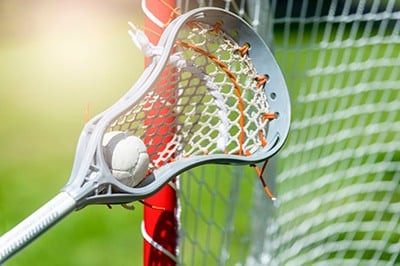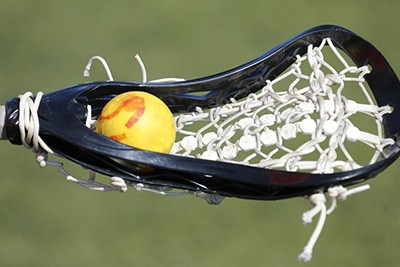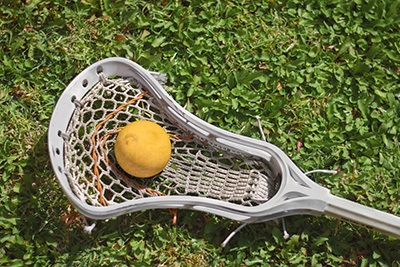Are you a lacrosse player looking for an easy way to string your stick? Look no further!
This comprehensive guide will walk you through the entire process so that you have a perfectly strung stick and an understanding of precisely how to do it.
With careful attention to detail, patience, and our step-by-step instructions below – how string lacrosse stick can be quickly done in just 20 minutes or less.
Let's get started so you can go out there and score some goals!
More...
Take Away Key Points:
Lacrosse Head Stringing: Basic Lacrosse Knots Procedures
Please refer to the procedures below if you need an essential lacrosse stringing guide. You will find the comprehensive steps to the ultimate lacrosse pole stringing methods.
Before we move on to the lacrosse stringing tutorials, several dimensions are crucial to lacrosse string length. These include:

- Lacrosse top string length: 22-24 inches
- Lacrosse head sidewall length: 22-24 inches
- Lacrosse bottom string length: 6-8 inches
- Lacrosse shooting string: personal preference. You do not need these strings if they don't help you much in the play.
Lacrosse string dimensions, from the length and width of the sidewalls and shooters to the diameter of the mesh hole, are essential aspects of a lacrosse stick's stringing configuration.
These factors help determine the overall strength and integrity of a lacrosse stick's pocket and significantly impact ball control and accuracy.
The correct dimensions will allow for greater velocity and accuracy and help extend your lacrosse stick's lifespan.
So, it's essential to understand all vital lacrosse string dimension measures when looking to customize your stick or when maintenance is needed.
Lacrosse Stick Stringing Guide: A Step-by-step Procedure
Once you have appropriate lacrosse stringing tools, you can begin stringing a lacrosse head. However, there is a pre-step to the procedure. Read below.
Step 1: Stretching lacrosse mesh out
Stretching lacrosse mesh will provide a better idea of the shape of the lacrosse pocket you are stringing.
If you don't stretch the lacrosse mesh, you will struggle to fix the lacrosse head and re-string the lacrosse stick later. You can use hot water to stretch it out more quickly for hard mesh.
In addition, the unstretched mesh can look different from what you had in mind. So, stretching the mesh fully before stringing the lacrosse head saves you time and energy.
Step 2: Preparing sidewall strings & top strings
When stringing a lacrosse head, you need a sidewall string for each side of the lacrosse head.
Use a double overhand knot instead of a standard overhand knot. Thus, you will prevent the sidewall string from pulling through the sidewall hole of the lacrosse head.
Your lacrosse pocket will stay consistent by preventing the issues in advance.
Step 3: Lacrosse top strings

The top string on the lacrosse head is the critical part when stringing the lacrosse stick (lacrosse head). The top string of the lacrosse head is the foundation to create a consistent lacrosse pocket.
Use the first nine-diamond top row and fold it over the next row to have a tight channel and even match. Next, apply the top sting/middle length string to make double knots, one end about 0.5 inches from the other.
Pull the string through the top sidewall hole in the lacrosse stick. Next, pull the string through the first diamond (end of string facing you) in the mesh and go back through that same first sidewall hole. The step ensures less whip, and the lacrosse stick won't break on you. Pull it tight through the first hole.
When the mesh is tight, the first knot comes into form. Pull the string through the first mesh diamond with the end turned toward you. The string goes through the first top hole in the scoop. Pull it through the next mesh hole on top or over the string to create a loop. Pull the string tight.
The string goes from the back of the mesh and through the same hole from the front of the scoop, leaving it loose. So, again, pull the string through the loop and make it tight.
Thus, you will make the first knot on the top string. Repeat the process as you move on, but create bigger holes and pull the mesh tight to keep the head shape optimal.
Once you reach the other side, repeat the first step, but tie a double knot to make it fixed and stable. Next, you should tie the other side, creating a single knot. It should have a diamond in the middle and be even.
Next, you will cut the extra string with scissors because you need about 0.5 inches of slack. After you cut the strings, use the lighter to prevent fraying.
Suppose the top string is loose. The lacrosse pocket will gradually become inconsistent since the mesh breaks in. Furthermore, loose top strings don't provide a good structure for the lacrosse pocket.
Thus, the lacrosse ball might hit off the plastic lip of the lacrosse head if the top string isn't tight. When a top string is crooked, the lacrosse pocket of the lacrosse ball will come out wrong, as the lacrosse head won't be symmetrical.
The top string offers the alignment of the stick channel, and players need a symmetrical top string to make an aligned channel for optimal performance.
Types of lacrosse top strings
There are several lacrosse head top string methods for beginners to choose from. The most popular techniques include:
The nine diamonds and the nine-diamond hidden are the two most popular methods to string a lacrosse head. The nine-diamond method is excellent for players using a low or mid-pocket. In addition, it's a simple top string for various operations.
On the other hand, the one-diamond hidden top string widens the channel, allows the mesh to float at the top, and allows the ball to sit higher. These methods will help you start a high pocket or add more control to the lacrosse stick.
Step 4: Stringing a lacrosse head sidewall

If you're uncertain how to string a lacrosse head sidewall, the procedure is given below.
When stringing a sidewall, you can prepare the lacrosse nylon string and tie a double knot. Ensure there is a knot on the opposite end of the sidewall.
Making a double knot at both sidewall parts will make you do both sides simultaneously. A single knot will add only slight security, so when you tie a double knot, it helps keep the sidewall stable.
Pull the string tight and knot it to the head as much as possible. Make the know using the same steps as the previous one. Then, poke the string through the third hole of the sidewall of the head. Pull the string until the knot is tight against the lacrosse head.
Stringing one sidewall knot on one side and then re-stringing it on the other side of the lacrosse head increases a more symmetrical and consistent pocket.
More experienced sidewall stringers can perform a sidewall knot individually on each side to save time. So, the first knot comes into its place once you pull the strings, and the mesh diamond will be fixed and tight for immediate use.
Stringing a lacrosse head simultaneously (both sides) can also help perfect your tension. The tension in your sidewall hole must be tight overall but also the same on each side to help you string a lacrosse head successfully.
When you notice you have done one side of the sidewall hole differently than the other, you must undo and fix the entire lacrosse sidewall. So, when you string the sidewall parts separately, you're prone to mistakes and cannot be sure if you're stringing the lacrosse stick correctly.
The size of the sidewall hole on the lacrosse head will determine how many loops there can be. A bigger sidewall hole will need more loops so the knot cannot go through. So it will stay stable.
Two loops on a starting knot ensure the knot won't slip through the sidewall hole for regular lacrosse heads. For instance, there might be two loops on your lacrosse head with a double overhand knot to ensure you can tie all parts of the knot tight. So it cannot slip through the hole once you tie the string tight.
Step 5: Stringing the pocket
Once you string the sidewalls of the lacrosse stick, you should string a perfect pocket. Next, wet the mesh with warm water and stretch the pocket out.
To string a lacrosse pocket successfully, you can use your fist. Another option to string a lacrosse pocket depth is to use a ball. You can throw it in and out on both sidewall parts. You will break the mesh.
However, there is a better way to pull the string and create an ideal pocket. First, you can take the ball and hold it in place. Next, you can slide a butter knife across the face of the head. Leave it there for ten minutes or during the whole night.
This step will create the necessary pocket and don't worry about a huge pocket depth. It will go back to its starting point. And you can always adjust the depth with the bottom string if the pocket of your lacrosse stick is too deep.
Step 6: Attaching the bottom string
The bottom string is the easiest and fastest way to finish the pocket. The bottom of the head has specific holes made for this step. You will want a knot on one end and pull it through one of those holes.
From where you finished off your sidewall, there should be a row of ten diamonds as the next row. However, you cannot use a nine-mesh diamond type, as it won't come out even for the bottom string.
Pull the string through the first diamond in that mesh-diamond row and weave it across. Next, take the bottom string out and pull the string through one of the other holes in the bottom part of the lacrosse head. Then, tie the bottom string off with a knot.
You should cut off the excess string (if any) and use the lighter to burn the ends together to prevent fraying. You'll ensure the bottom string is tight and stable.
READ MORE
Step 7: Attaching the shooting strings
This method is optional, as many players play without any shooters. However, this is not frequent, and experts do not recommend this string method. But, if players prefer it, the technique is legal.
On the other hand, various players use shooting strings in lacrosse heads to adjust how they throw and shoot the lacrosse ball. You can use the shoelace-like strings to attach the shooting strings to your lacrosse heads.
For beginners, it would be best not to use nylon strings as the shooting strings since using them will add whip to your lacrosse heads, forcing you to throw balls differently than you should.
In addition, the method does not allow you to follow through, so before you start stringing, you should know how to adjust your pace and game to perform better with your lacrosse stick. So, take your shooting string and choose the first row of nine mesh-diamonds (mesh hole) down from the scoop of the head.
It would help to start the shooting strings on the right side of the head (if the head of the lacrosse stick is facing down, the pocket placement is up). The step prevents the strings' ends from hitting you in the face while cradling.
Pull the string between your mesh diamond and the sidewall. Ensure both sides of the string are even in length. Keep even tension during the procedure.
Take the end of the string facing away from you and pull the string up towards you. The other side goes down through the second row of mesh-diamond. Interweave the string across that same diamond-mesh row until you reach the other side of the lacrosse head and tie it off with a knot.
For the next hole, you will repeat the process, but on the next mesh diamond, row down. So, skip the same row and start there. Once you finish, you will create the U-String shooter in the bottom row.
This shooting string allows you to follow through and gives the right amount of whip and control. However, it won't give too much whip to prevent struggles with throwing in the long passes.
The curve of the U-String takes place on the next mesh diamond row down and occupies three diamonds. However, in college lacrosse, players are not allowed U-shooting strings, as these are illegal. Once you discover your playing style, you can add nylon or another straight string to make the U-shooter.
Still, to form the U-style, you need to find three diamonds in the mid pocket to mark the beginning of curving your shooter. Follow the mesh diamond row down and diagonally toward the bottom side of the head of the lacrosse stick.
Pull the string similar to the straight shooter string, but this time, go diagonally.
Ensure the shooter curves and makes the U-shape on the three middle diamonds. Then, you can start stringing the diagonal path down to the other side of the stick's head. Finally, tie the string off with a knot to finish the method.
READ MORE
FAQs
Is stringing a lacrosse stick hard?
Yes, stringing a lacrosse stick can be hard for beginners, but once you try a few times, it will become your routine.
How long does it take to string a lacrosse stick?
You can string your stick in thirty minutes or less.
How much does it cost to restring a lacrosse stick?
The price in the USA varies from $10 to $25.
How to string a triangle top string?
To string a triangle top string, follow the steps below:
- Prepare your stringing materials
- Make a double overhand knot
- String the single string
- Wrap the top string knot
- Keep going down the scoop of the lacrosse head
- Finish the string
Where to string a lacrosse head if I can't do it myself?
A great option is to find a local shop or sporting goods store that offers the service.
There are also plenty of online tutorials and video demonstrations with instructions for stringing lacrosse heads.
Conclusion
Stringing a lacrosse stick can be intimidating for beginners. Coming up with the correct pattern of how string lacrosse stick may seem difficult without the right know-how. However, once you get going, it will take less than half an hour to complete.
If you are unfamiliar with the process, watch some tutorials, lace up one of your friend's sticks, or speak to someone at a local store who can give you step-by-step instructions.
Stringing also comes with an incredible feeling of satisfaction, knowing that all your hard work has resulted in a perfect stick for playing and is ready to go!

Freddy is the heart and soul of Lacrosse Runner. As a former athlete, Freddy is very passionate about Lacrosse. He keeps up with the sport’s changes and innovations and often tests the new equipment released by the leading manufacturers. Read more here
